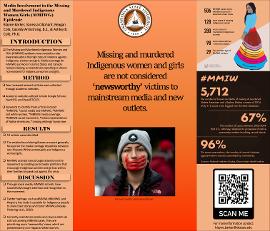| dc.contributor.advisor | Cole, Ashley B. | |
| dc.contributor.author | Barker, Blayne | |
| dc.contributor.author | Oliphant, Vanessa | |
| dc.contributor.author | Cole, Reagan | |
| dc.contributor.author | Armstrong, Cassidy | |
| dc.date.accessioned | 2022-04-19T13:18:55Z | |
| dc.date.available | 2022-04-19T13:18:55Z | |
| dc.date.issued | 2022-04-19 | |
| dc.identifier | oksd_URS_2022_barker | |
| dc.identifier.citation | Barker, B., Oliphant, V., Cole, R., Armstrong, C., & Cole, A. B. (2022, April 19). Media involvement in the Missing and Murdered Indigenous Women/Girls (MMIWG) epidemic. Poster session presented at the Oklahoma State University Undergraduate Research Symposium, Stillwater, OK. | |
| dc.identifier.uri | https://hdl.handle.net/11244/335245 | |
| dc.description.abstract | The Missing and Murdered Indigenous Women and Girls (MMIWG) epidemic was created to raise awareness about the high rates of violence against Indigenous women and girls. Media coverage for MMIWG survivors in United States and Canada remains lacking, as mainstream reporting is almost non-existent for Indigenous women and girls. Out of 506 MMIWG cases, only one-quarter were reported by local, regional, or national media (UIHI, 2018). These victims are commonly overshadowed by other cases comprised of non-Hispanic White (NHW) women who go missing. In Canada's local press, missing and murdered NHW women were referred to 511 times compared to 82 times for Indigenous women (Gilchrist, 2010). Further, Indigenous women and girls who are abuse survivors and are reported in the media are usually depicted in negative and stereotypical contexts like sex-work and criminal behavior, which is in stark contrast to their NHW counterparts. However, advocates of the MMIWG epidemic have created increased social media exposure by sharing survivors' stories. During an 11-month study using data from Twitter, over 107,400 tweets included #MMIW and #MMIWG; these hashtags were used to shift perceptions of Indigenous women/girls and to apply political pressure to increasing news coverage of current rates of MMIWG (Moeke-Pickering et al., 2018). Increasing Indigenous representation and exposure via the media creates the opportunity to generate discussions, encourage activism, and ultimately, promote systemic-level changes for justice among Indigenous women and girls. The purpose of this poster presentation is to highlight the impact of media involvement in relation to the MMIWG epidemic. | |
| dc.format | application/pdf | |
| dc.language | en_US | |
| dc.publisher | Oklahoma State University | |
| dc.rights | In the Oklahoma State University Library's institutional repository this paper is made available through the open access principles and the terms of agreement/consent between the author(s) and the publisher. The permission policy on the use, reproduction or distribution of the article falls under fair use for educational, scholarship, and research purposes. Contact Digital Resources and Discovery Services at lib-dls@okstate.edu or 405-744-9161 for further information. | |
| dc.title | Media involvement in the Missing and Murdered Indigenous Women/Girls (MMIWG) epidemic | |
| osu.filename | oksd_URS_2022_barker.pdf | |
| dc.description.department | Psychology | |
| dc.type.genre | Poster | |
| dc.type.material | Text | |
| dc.type.material | Image | |
| dc.subject.keywords | MMIWG | |
| dc.subject.keywords | MMIW | |
| dc.subject.keywords | Indigenous | |
| dc.subject.keywords | media | |
| dc.subject.keywords | news coverage | |
